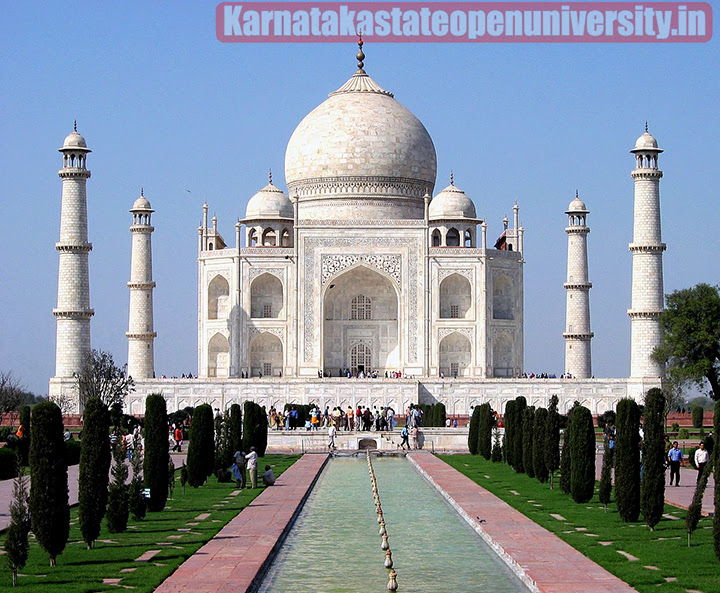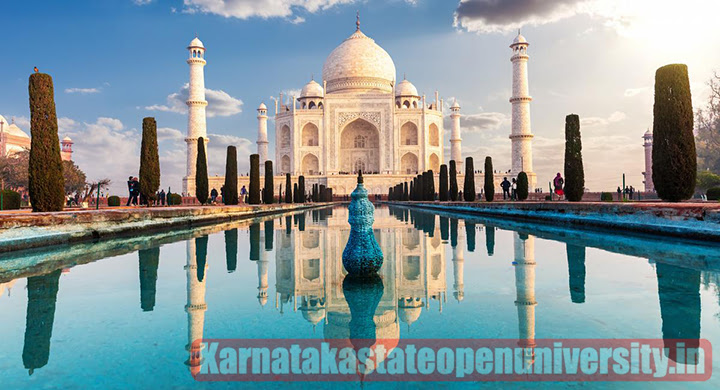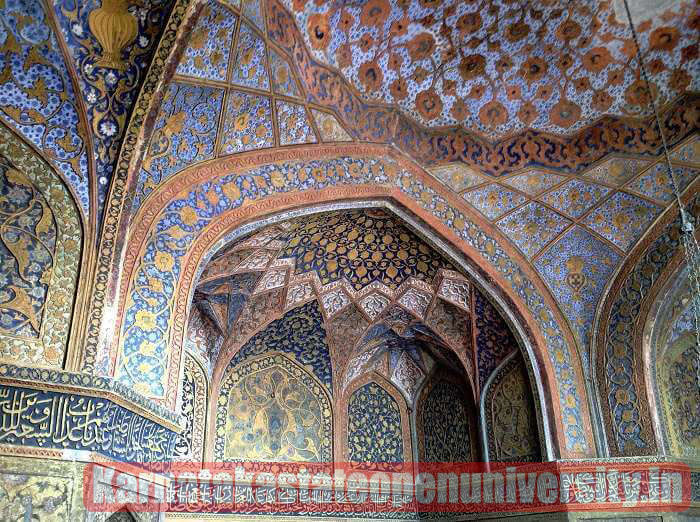Taj Mahal – The powerful political state that rule India from the 16th century to the 19th century, the Mughal Empire, is not widely known. However, their most well-known building is well-known to almost everyone. In Agra, India, the massive mausoleum and funerary complex known as the Taj Mahal was construct in the 17th century. It is a memorial to a pretty great love story and one of the world’s most famous buildings.
The Taj Mahal is a mausoleum made of ivory-white marble that stands gracefully on the pedestal of Agra. Its perfect image is reflected in the pool of reflection in front of it, giving it an eerie appearance. It is said that, depending on the weather, season, and time of day. The place changes color by reflecting the sky’s ever-changing hues. The mausoleum feels like an alive and enchanted symbol of love due to the walls’ changing colors.
Taj Mahal
Taj Mahal, likewise spell Tadj Mahall, sepulcher complex in Agra, western Uttar Pradesh state, northern India. The Mughal emperor Shah Jahan, who reign from 1628 to 1958, built the Taj Mahal to commemorate his wife Mumtaz Mahal, also known as the “Chosen One of the Palace.” Mumtaz Mahal had been the emperor’s inseparable companion since their wedding in 1612. She died in childbirth in 1631. It is India’s most famous and well-known structure. It is in the eastern part of the city, on the right bank of the Yamuna (Jumna) River, on the southern side. The Taj Mahal is approximately 1 mile (1.6 km) to the west of Agra Fort (Red Fort), which is also on the right bank of the Yamuna.
The Taj Mahal is regard as the finest example of Mughal architecture, a blend of Indian, Persian, and Islamic styles, due to its harmonious proportions and fluid incorporation of decorative elements. A museum, beautiful gardens, and two mosque buildings that are symmetrically positioned on either side of the mausoleum are additional points of interest. The Taj Mahal is one of the world’s most iconic monuments and one of the most beautiful structural compositions. Millions of tourists come to see it every year. In 1983, the complex was made a UNESCO World Heritage Site.

Taj Mahal Agra Details
| Article for | Taj Mahal Agra, Story, History, Architecture and Facts about Taj Mahal In 2024 |
| Taj Mahal Agra, Story, History, Architecture and Facts about Taj Mahal In 2024 | Click Here |
| Category | Travels |
| Official website | Click Here |
click here:- Agra Fort: Agra All you need to Know In 2024
Taj Mahal
The architecture of the Taj Mahal perfectly blends Islamic, Persian, and Indian styles. This monument was construct with approximately 22,000 workers. From all over Asia and Iran, stonecutters, painters, masons, dome builders, calligraphers, inlayers, and carvers were recruit.
It amazes everyone who sees it. It is construct in such a way that, even after hundreds of years, it retains its beauty and charm. Ustad Ahmad, a Lahore-based architect who worked in Shah Jahan’s court, was in charge of the design of this stunning monument.
History
The story of the Taj Mahal begins with the love story of between a king and his wife and continues for centuries to come on. Here is an overview of the history of the Taj Mahal, Agra.
Shah Jahan and Mumtaz Mahal’s love story: Shah Jahan was the fifth sovereign of the Mughal Domain, and he ruled over what is currently viewed as the brilliant time of Mughal engineering. In 1631, Shah Jahan’s dearest spouse, a Persian princess whom he gave the epithet “Mumtaz Mahal” (signifying “gem of the royal residence”) kicked the bucket bringing forth their fourteenth kid. A troubled Shah Jahan spent almost two years in extraordinary grieving for Mumtaz Mahal. And development on a spot to house her remaining parts started in 1632. The Taj Mahal would be build on this.
Construction of the Taj Mahal: Ustad Ahmad Lahauri, who is thought to have been the chief architect, and Mir Abdul Karim, who is listed as a supervisor, were the two architects Shah Jahan hired to work on the Taj Mahal’s design. His own Jama Masjid in Delhi and other Mughal mausoleum designs served as sources of inspiration. Stonecutters, calligraphers, embroiderers, and painters were among the 22,000 workers who completed the project. It is claim that 1,000 elephants were need to transport the bulky building materials. Six years after it was build, the main mausoleum was finish in 1638. By 1653, all of the additional components of the Taj Mahal complex—the guest house, mosque, main gateway, outer courtyard, and cloisters—were finish. After building the Taj Mahal, Shah Jahan live in Agra Fort under house arrest until his death in 1666. When he was buries there with his wife.
Eighteenth-century attacks: In the eighteenth century, the Jat kings of Bharatpur attacked the Taj Mahal. Two chandeliers, two of the tomb’s one-of-a-kind stone-carve marble screens, and a shield that cover a finial on the main dome were taken.
Twentieth-century restoration and modern-day status: Lord Curzon, the British viceroy to India from 1899 to 1905, started a project to restore the Taj Mahal, which had fallen into disrepair, at the end of the 19th century. In 1908, the restoration, which include new gardens of European design in place of the traditional Mughal gardens, was finish. Later in the century, a great deal of scaffolding was erect around the Taj Mahal during World War II and again during the Indian-Pakistan Wars. Which last from 1965 to 1971, to make bombers think that the Taj Mahal was not there. Due to its status as a “jewel of Muslim art,” the Taj Mahal was designate a UNESCO World Heritage Site in 1983. It was list as one of the New Seven Wonders of the World in the year 2000.

Check Also:-Top 10 Luxury Hotels in India 2024 For Travel
Architecture of Taj Mahal
Taj Mahal was refer to by the well-known Indian poet Rabindranath Tagore as “a teardrop on the cheek of eternity.” The famous English poet Rudyard Kipling described the Taj Mahal’s beauty as “the embodiment of all things pure.” Also, the maker of Taj Mahal, the Mughal Sovereign Shah Jahan said it made ‘the sun and the moon shed tears from their eyes. It’s no wonder that the Taj Mahal is one of the world’s most fascinating architectural wonders. Thousands of tourists travel to Agra each year to admire the Taj Mahal.
The Taj Mahal is a stunning white marble mausoleum that was construct between 1631 and 1648 under the direction of Mughal Emperor Shah Jahan. On the banks of the Yamuna River in Agra, it is in an excellent location. During that time, it was about 32 crores in cost. In honor of his beloved wife Mumtaz Mahal, he built it. The prestigious designations of “UNESCO World Heritage Site” and “One of the Seven Wonders of the World” are testaments to its architectural splendor.

Symbol of Love
The contemporary accounts support the widespread perception that the Taj Mahal is one of the world’s monuments to a great “love story,” and the majority of scholars agree that this view has a solid foundation in reality. The building was also use to spread Jahani propaganda about the Mughal leadership’s “perfection.” Contemporary academics disagree on the extent to which the Taj uses propaganda. This period of Mughal architecture best exemplifies the development of a style that combined Islamic and indigenous styles. When the Mughals constructed the Taj, however pleased with their Persian and Timurid roots. They had come to consider themselves to be Indian. “Although it is unquestionably a native Indian production, its architectural success rests on its fundamentally Persian sense of intelligible and undisturbed proportions, applied to clean, uncomplicated surfaces,” Copplestone writes.
Current problems of Taj Mahal
The Taj Mahal has been neglect and deteriorate over time. A significant reclamation was done toward the start of the twentieth 100 years under the course of Ruler Curzon, then, at that point, the English emissary of India. The mausoleum has recently suffer damage, particularly to its marble facade. As a result of air pollution brought on by vehicle exhaust and emissions from foundries and other nearby factories. The monument’s threat has been reduce by closing some foundries, installing pollution-control equipment in others, creating a parkland buffer zone around the complex, and prohibiting vehicular traffic in the area. In 1998, work to restore the Taj Mahal and conduct research was start. However, there has been a lag in the improvement of the monument’s surrounding environment.
The Taj Mahal has occasionally been affect by Indian politics. Between 1984 and 2004, nighttime viewing was prohibit due to concerns that Sikh militants might target the monument. Additionally, it is increasingly being regard as an Indian cultural icon. In an effort to minimize the significance of Muslim influence in determining the Taj Mahal’s origins and design. Some Hindu nationalist organizations have attempt to discredit it.
Conclusion
On the south bank of the Yamuna river in the Indian city of Agra is the Taj Mahal. A white marble mausoleum. Shah Jahan, the Mughal emperor who ruled from 1628 to 1658. The ordered it built in 1632 to house Mumtaz Mahal, his favorite wife. Millions of people come to see the Taj Mahal every year, making it one of the world’s most popular tourist destinations. Even though it was given the status of a UNESCO World Heritage Site in 1983 and is currently manage by the Archaeological Survey of India. The site’s high visitor volume is just one of many things that could compromise its integrity. To be fair, millions of tourists choose to visit the Taj Mahal.
The authorities in charge of the site need to make every effort to implement legal and structural measures in order to guarantee the continue existence of this priceless monument as global tourism expands and industry economic pressures continue to rise.
Related Posts:-
Bhangarh Fort: Story of the Most Haunted Place In India
Chittorgarh Fort: A epic tale of love
Chitradurga Fort Karnataka All you need to Know In 2024
Lohagad Fort Maharashtra History, Timing All you need to know In 2024